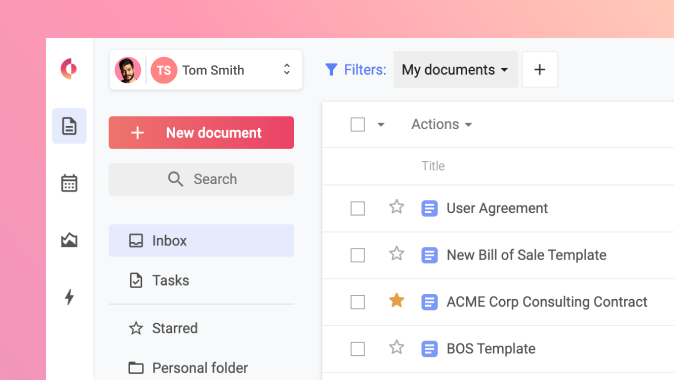The Top 10 Contract Management Questions of 2020
It’s time to evaluate solutions. Where do you begin? How do you know what is nice-to-have versus need-to-have. What are the key questions you should be asking when researching contract management solutions?
Over the last three years we’ve collected the most frequently asked questions, asked across industry verticals and company sizes. This list answers those questions to help you get the right solution for your needs. Let’s dive in.
1. How long does onboarding take?
A loaded question with a variety of answers, depending on the type of solution purchased.
The reason: the more customization of a product, the longer the implementation time. Also, the more customization the harder the push for adoption and possibly the lower the adoption rate or success for the change initiative.
An industry benchmark for onboarding for a contract management solution is 200 users in two weeks, fully up-and-running.
The more intuitive a product—one, onboarding should be relatively short, and two, the adoption rate should be high giving you a much quicker time-to-value.
Additionally, with the onboarding or implementation conversation, fees should be addressed, including fees for training—do the fees exist and what is the timeline for training or training provided, for example.
Onboarding and training should be included in the overall quoted price. Asking questions about each of these points will help you address the question of timeline and what is acceptable for your use case.
Lastly, when discussing implementation time ask about maintenance fees. Are there any? When do they go into effect? It’s our belief maintenance fees should be included in the overall price tag, but if the solution you’re leaning towards does include them ask when they go into effect—if the implementation time is 6-8 months but maintenance fees go into effect on the day you sign the contract negotiate the start date and save some money.
2. What happens with our legacy contracts?
What we’re really talking about here is creating a single source of truth. Granting more visibility, control, compliance, opportunities for savings, etc.
In an ideal situation you will be able to upload all contracts into the platform using it as a central repository. Many providers will handle the migration of your old contracts for you. Make sure to ask if one, this type of capability for upload or central repository exists, two, if any fees are associated, and three, whether the contract metadata can be migrated as well.
To the single point of truth – it is of course possible to use backup solutions such as Sharepoint, Dropbox, and Box for example, although not necessary depending on the CLM you’re evaluating. So if your processes or desired outcome include something like this, it is possible to integrate, we’ll talk about this next.
3. Which integrations are available?
Let’s address this then as a two-part question.
The first question to ask is which integrations come “out of the box.” Beware: not all integrations are equal, meaning that some are more thorough and allow for more functionality. Ensure the integrations offered meet your needs. If you’ve mapped your contract process throughout the organization this will help you understand the integration points between software and what you will need to look for.
The second question then is do you have an open API? An open API allows software to connect with any other software by building an integration- think legos.
Ultimately, you may want a solution with an open API, so your IT team can create custom integrations that work for your purposes. A point to highlight: know what you need from a process and technical standpoint. Involve your IT team, your operations team; they will know what specific requirements are needed.
4. How should we structure our team to use it?
Think about how your team currently creates, negotiates, signs, and manages contracts; what is the current process for each part? Who is involved in each step; who needs access to creating or approving documents versus who might only need access to a contract once in a while for review. All things to consider.
After sketching that out, determine who needs to be an admin – who will be ultimately managing users and overseeing the process – and therefore have full access to the info in your contracts. Who might lead teams and need to be approved for a larger body of users?
Do you have subsidiaries to manage and is that even a capability of the solution?
Doing this analysis before coming to the table will help you understand more fully your processes and needs, and help the vendor successfully map out a solution that will best fit your needs.
5. What level of customization can I expect?
What’s important to you when it comes to customization? Inboxes, dashboards, documents, processes? What are you looking to achieve? Is it really customization you’re looking for or is it flexibility within a solution to adapt to your needs and different contract types or use cases? These are great questions to address when starting the conversation around needs and what a solution can provide.
To harken back to the implementation conversation, over-customization increases implementation time, but it can also make for a less efficient process. Aside from slower adoption, highly customized solutions can be harder to maintain and hard to change. The reverse, a simple, intuitive solution will encourage sustained adoption by your team members, even in other departments and simplify change management.
6. What is the 3rd party experience?
Your invited third-party guests, whether they are invited to sign or negotiate a contract should be able to access said contracts in the system without creating an account or paying any type of fee.
After addressing the monetary conversation, inquire about how these third parties are invited to sign or to negotiate or collaborate on a document.
Does negotiation still require emailing a document back-and-forth? Will you need to be working in Word or PDF or can you negotiate online within the solution? Will all the changes, comments, redlines, etc. be automatically tracked? Is the signature secured using a secondary solution to the contract management solution? Will you have to pay for that additional e-signature solution outside of the costs of the contract management solution?
An invited third-party should not incur fees to collaborate with your, not should you need to pay for them – it’s simply not scalable and still leads a largely manual process.
Understanding the experience and functionality from a third-party perspective will help you gain adoption from those third-parties and have a more comprehensive understanding of how the solution fits into your process flow.
7. How can we set up who approves contracts?
A solution should incorporate users permissions and roles that empower you to set up admins, teams, etc. according to your processes. It should also include approval workflows, at a minimum at the document level but ideally at the company level, where you can create a workflow for a type of document or process and include it on any contract or document created. This type of company-level workflow enables you to easily make changes if, say, someone leaves or a process changes. Take an inventory of your current contract processes so you have a clear understanding of your workflows before even using a contract management solution, and investigate different levels of editing and access permissions available. Lastly, understand how subsidiary management works with each solution you’re evaluating—can you do it (you should be able to), how is it structured, and what do those user access and permission rights look like.
8. Where is the data located; how is it backed up?
There is a large conversation that can be had around data, too big for this discussion. However, we can tackle one of the biggest areas of concerns which is around data-locality, which is going to be largely based on your needs and security requirements. When it comes to where data is stored there are basically two options: the Cloud or on-premise. A cloud-based system has advantages over on-premise in terms of ease of maintenance, accessibility, and in many cases security. When it comes to security and data conversation it’s helpful to loop in your IT team early to get a firm understanding of the system and security requirements to look for when evaluating. Additionally, if evaluating a Cloud solution, ask what servers is in use, AWS, MS, Azure, etc. Sometimes considered the ghost at the table, a third party server such as one of these can affect security and is a consideration for meeting risk, liability, and indemnity concerns. (Note, when contacting contract management vendors ask for their security information. They should have a security review sheet available and ready for share.)
9. How can we track and use metadata?
Have the vendor take you through what it looks like to upload existing contracts and then to access that legacy information.
Metadata, the critical data in your contracts, can be used in a multitude of ways and having a clean, clear way to track it and report on it is essential.
Make sure you have an option to notate and track metadata within the product, as well as export it. Exporting data empowers additional reporting capabilities, especially when it comes to manipulating data and creating robust reporting for the powers that be or the C-suite.
At Concord, we use a feature called the Summary Sheet—a side panel that exists on every contract that allows you to enter and track dates, clauses, business-critical fields, and tags. This information can then be pulled into reporting to grant visibility into your processes and overall contract corpus.
10. How will we grow with this solution?
A key to evaluating software is to not only consider current challenges and processes, but to also evaluate growth and how the system will accommodate future needs. How adaptable is the solution?
To address future needs, choose a solution that is flexible, that can be used across multiple use-cases and departments organization-wide. A contract management platform like Concord is flexible, adaptable, and scalable, easily changing with you as business needs change.
Lastly, consider storage limitations—how many documents can the system host? A solution should allow unlimited documents so it never limits you, how you do business, or caps your growth.
A great start to getting the solution that will best fit your needs, this list of the top ten questions and their answers is only the beginning. For a more comprehensive guide to buying a contract management solution, check out The Complete Contract Management Solution Buyer’s Guide.
Want to talk contract management?
Get a personalized demo Try it, free
Concord’s mission is to help companies achieve scalability and efficiency by automating their most central process, contracts. The cloud-based solution enables over 400,000 users around the globe to create, collaborate, sign, store, and manage their agreements all in one place. Founded in 2014 and headquartered in San Francisco, Concord is built by business for business.



